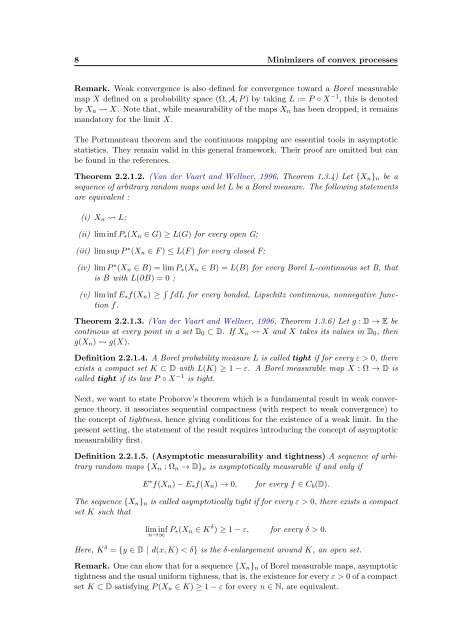Subsampling estimates of the Lasso distribution.
Subsampling estimates of the Lasso distribution.
Subsampling estimates of the Lasso distribution.
Create successful ePaper yourself
Turn your PDF publications into a flip-book with our unique Google optimized e-Paper software.
8 Minimizers <strong>of</strong> convex processes<br />
Remark. Weak convergence is also defined for convergence toward a Borel measurable<br />
map X defined on a probability space (Ω, A, P ) by taking L := P ◦ X −1 , this is denoted<br />
by X n X. Note that, while measurability <strong>of</strong> <strong>the</strong> maps X n has been dropped, it remains<br />
mandatory for <strong>the</strong> limit X.<br />
The Portmanteau <strong>the</strong>orem and <strong>the</strong> continuous mapping are essential tools in asymptotic<br />
statistics. They remain valid in this general framework. Their pro<strong>of</strong> are omitted but can<br />
be found in <strong>the</strong> references.<br />
Theorem 2.2.1.2. (Van der Vaart and Wellner, 1996, Theorem 1.3.4) Let {X n } n be a<br />
sequence <strong>of</strong> arbitrary random maps and let L be a Borel measure. The following statements<br />
are equivalent :<br />
(i) X n L;<br />
(ii) lim inf P ∗ (X n ∈ G) ≥ L(G) for every open G;<br />
(iii) lim sup P ∗ (X n ∈ F ) ≤ L(F ) for every closed F;<br />
(iv) lim P ∗ (X n ∈ B) = lim P ∗ (X n ∈ B) = L(B) for every Borel L-continuous set B, that<br />
is B with L(∂B) = 0 ;<br />
(v) lim inf E ∗ f(X n ) ≥ ∫ fdL for every bonded, Lipschitz continuous, nonnegative function<br />
f.<br />
Theorem 2.2.1.3. (Van der Vaart and Wellner, 1996, Theorem 1.3.6) Let g : D → E be<br />
continous at every point in a set D 0 ⊂ D. If X n X and X takes its values in D 0 , <strong>the</strong>n<br />
g(X n ) g(X).<br />
Definition 2.2.1.4. A Borel probability measure L is called tight if for every ε > 0, <strong>the</strong>re<br />
exists a compact set K ⊂ D with L(K) ≥ 1 − ε. A Borel measurable map X : Ω → D is<br />
called tight if its law P ◦ X −1 is tight.<br />
Next, we want to state Prohorov’s <strong>the</strong>orem which is a fundamental result in weak convergence<br />
<strong>the</strong>ory, it associates sequential compactness (with respect to weak convergence) to<br />
<strong>the</strong> concept <strong>of</strong> tightness, hence giving conditions for <strong>the</strong> existence <strong>of</strong> a weak limit. In <strong>the</strong><br />
present setting, <strong>the</strong> statement <strong>of</strong> <strong>the</strong> result requires introducing <strong>the</strong> concept <strong>of</strong> asymptotic<br />
measurability first.<br />
Definition 2.2.1.5. (Asymptotic measurability and tightness) A sequence <strong>of</strong> arbitrary<br />
random maps {X n : Ω n → D} n is asymptotically measurable if and only if<br />
E ∗ f(X n ) − E ∗ f(X n ) → 0,<br />
for every f ∈ C b (D).<br />
The sequence {X n } n is called asymptotically tight if for every ε > 0, <strong>the</strong>re exists a compact<br />
set K such that<br />
lim inf<br />
n→∞ P ∗(X n ∈ K δ ) ≥ 1 − ε, for every δ > 0.<br />
Here, K δ = {y ∈ D | d(x, K) < δ} is <strong>the</strong> δ-enlargement around K, an open set.<br />
Remark. One can show that for a sequence {X n } n <strong>of</strong> Borel measurable maps, asymptotic<br />
tightness and <strong>the</strong> usual uniform tighness, that is, <strong>the</strong> existence for every ε > 0 <strong>of</strong> a compact<br />
set K ⊂ D satisfying P (X n ∈ K) ≥ 1 − ε for every n ∈ N, are equivalent.
















